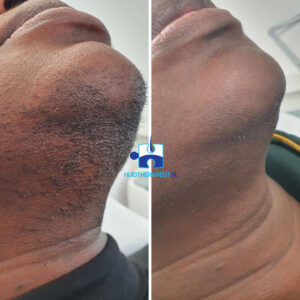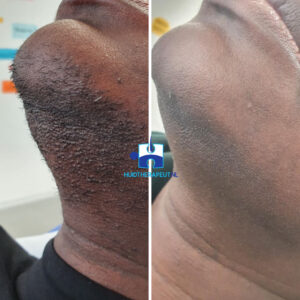We speak of excessive hair if there is excessive hair growth in places where normally no or only thin hairs grow. In addition to excessive hair, it also happens that hairs grow in. Ingrown hair can lead to inflammation and later scars.
Forms of excess hair
There are two forms of excessive hair growth: hypertrichosis and hirsutism. They usually occur separately, but can also occur in combination.
Hypertrichosis
Hypertrichosis is excessive hair growth in places where there is already some hair growth by nature. Fine hairs may appear on the face, temples and eyebrows. Hair on the arms can lengthen and increase in number. The lower legs and torso are usually heavier hairy. Hypertrichosis occurs in both men and women. It develops during puberty.
Hirsutism
With hirsutism, women get hair in places where usually only men develop hair. Instead of down hair, a lot of dark hair appears in areas such as the upper lip, cheeks, chin and neck, around the nipples, on the chest, back, abdomen and groin area. Hair growth is also more than “normal” on the arms and legs.
Skin conditions with ingrown hair
An ingrown hair causes inflammation of the skin. This creates a small pimple where the hair is stuck.
Folliculites barbea
Ingrown hairs in the beard area that are accompanied by irritation and inflammation are called follliculitis barbea. Ingrown hairs in the beard region are more common in people with frizzy hair. People who shave the hair very short also suffer from ingrown hair in the beard region.
Acne Inversa / Hidradenitis Supperativa
Acne inversa, also known as hidradenitis supperativa, is a serious form of acne that mainly occurs in the groin, armpits and buttock fold. This is a chronic inflammatory reaction of the hair follicles. This inflammatory reaction blocks the opening of the hair follicle. The sebum can no longer get out of the skin, causing a large blockage. These inflammations are accompanied by a lot of pain and pus.
Sinus pilonidalis
A pilonidal sinus is a cyst in the fold of the buttock. This cyst arises because the hairs grow into the buttock fold. The ingrown hair causes an abscess and / or inflammation.
Cause of excessive hair
Human hair growth is genetic and depends on age, race and hormonal factors. After a hair is created in the hair follicle (hair follicle), it takes months or years to fall out. After a rest period – ranging from six weeks to a year and a half – a new hair grows out of the hair follicle. So only part of our hair is visible. If after epilation or waxing it seems that the hair comes back after a week, it is really another hair that grows right next to it.
Our genes and hormones determine where hair appears on the body, they determine the amount and thickness of the hair and ultimately whether we have light or (too) heavy hair.
PCOS
PCOS is short for polycystic ovary syndrome. The syndrome occurs in women who have hormonal abnormalities. This can cause cysts to grow on the ovaries. An important symptom of PCOS is that someone has irregular or almost no periods. Because of this hormonal disorder, someone with PCOS also more often suffers from acne and excessive hair. Excessive hair occurs all over the body, both in the face and other parts.
Cause ingrown hair
Ingrown hairs are more common in people where the hair is curled. Because the hair curls, the hair grows back into the skin. This gives an inflammatory response. It is also possible that the hair is shaved too short, so that the hair grows back into the skin later. Ingrown hairs also occur in various skin conditions as mentioned above: Folliculites barbea, Acne inversa and Sinus pilonidalis
How can you treat excessive hair?
Excess hair can be treated by the skin therapist by applying electric depilation or laser hair removal. During the free and no-obligation intake interview, it will be discussed which method will be the most effective, this will be personally tailored to your complaint.
Treatment results
Reimbursement by health insurers
Laser hair removal is (partially) reimbursed by most insurance companies. Ask your skin therapist for advice if you are unsure whether a certain treatment is reimbursed.





